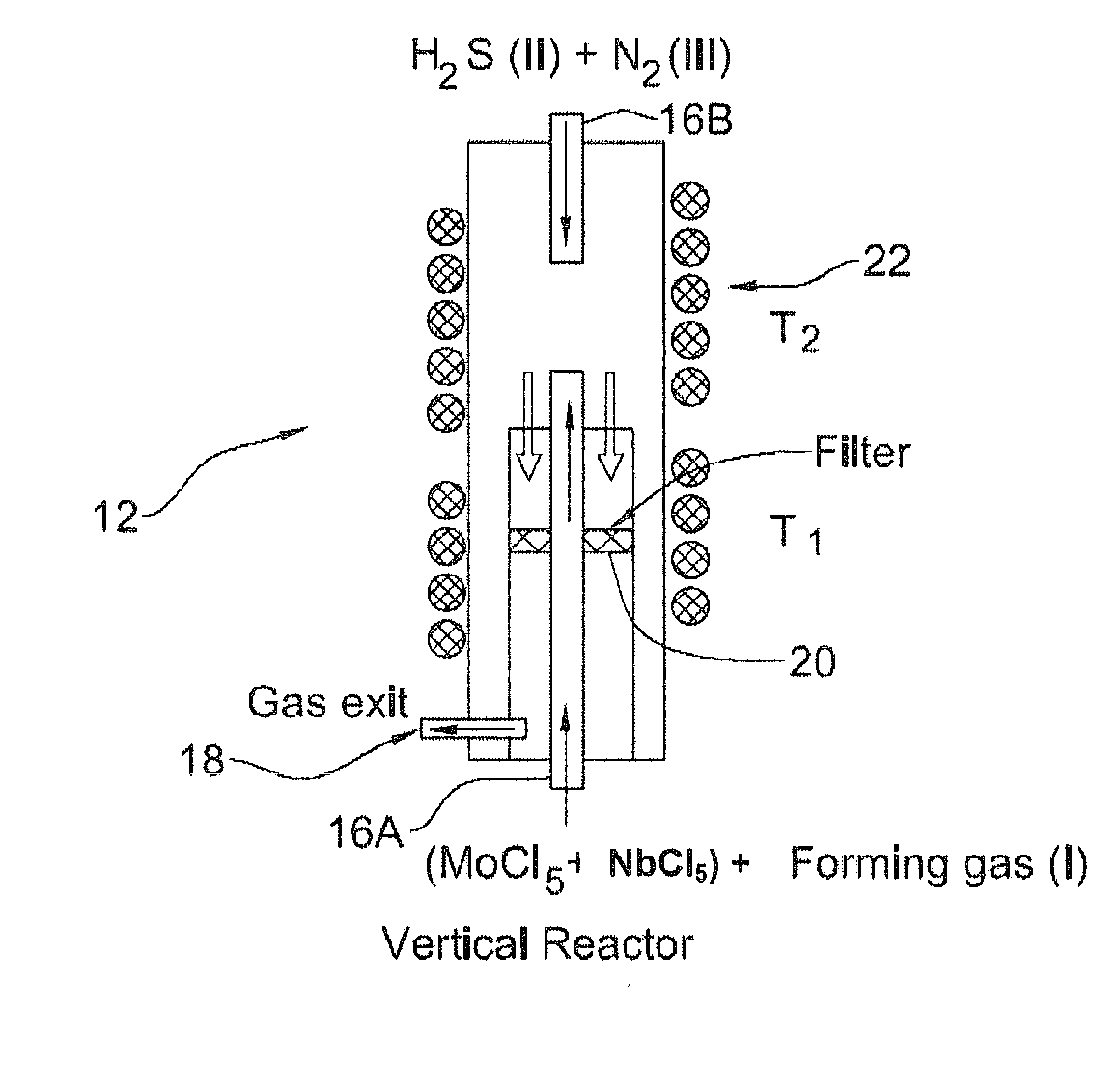Fullerene-like nanostructures, their use and process for their production
a technology of fullerene-like nanoparticles and nanotubes, which is applied in the direction of magnetic bodies, non-metal conductors, magnetic paints, etc., can solve the problems of not being able to achieve scientific and experimental confirmation of the control of electrical properties of nanotubes or fullerene-like nanoparticles by alloying/doping, and achieve high conductivity semiconductors
- Summary
- Abstract
- Description
- Claims
- Application Information
AI Technical Summary
Benefits of technology
Problems solved by technology
Method used
Image
Examples
example 1
Preparation of IF Mo1−xNbxS2 nanoparticles
[0094]The synthesis of the IF-Mo1−xNbxS2 nanoparticles was carried out starting from the precursors MoCl5 (Aldrich) and NbCl5 (Alfa Aesar) in reaction with H2S using the vertical reactor shown in FIG. 2A. Before each growth session, the vertical reactor being the reaction chamber 12 was preset to higher temperatures of about 600° C. and was purged continuously with N2 in order to prevent traces of O2 and water vapor that would otherwise interfere with the course of the reaction.
[0095]Precursors MoCl5 (0.550 g; m.pt=194° C., b.pt=268° C.) and NbCl5 (0.010 g m.pt=204.7° C., b.pt=254° C.) were first heated in the auxiliary furnace (evaporation chamber) 14 to a temperature of ˜250° C. (T4). In order to avoid condensation of the vapors of the precursor, before it reaches the vertical reactor 12, a preset temperature of 220° C. (T3) was maintained along the length of a tube (not shown) connecting the chambers 14 and 12 using a heating band. The va...
example 2
Synthesis of Mo1−xRexS2 IF-nanoparticles
[0128]The synthesis was carried out in a method similar to the above-described synthesis of the IF-Mo1-−xNbxS2 nanoparticles. The precursors in this case are MoCl5 (m.pt=194° C.; b.pt=268° C.) and ReCl5 (m.pt=220° C.).
[0129]FIGS. 13A and 13B show together an experimental setup used in the present example. Reference numbers are the same as those used in FIG. 2. Initially, the precursors were heated (temperature T3) in a separate auxiliary furnace 14 (FIG. 13B) and the respective vapors were carried while heated at a temperature T2 into the main reactor 12 (FIG. 13A). The latter being a horizontal reactor, although one may carry the reaction in a vertical reactor similar to that described previously in the case of the synthesis of IF-Mo1−xNbxS2 nanoparticles, with reference of FIG. 2. As for the horizontal reactor, which was previously used for the synthesis of IF-TiS2 nanoparticles, it now has been modified for the synthesis of the IF-Mo1−xRexS...
example 3
Synthesis of W1−xRexS2] IF-nanoparticles
[0139]The synthesis was carried out in a method and an apparatus similar to the above-described synthesis of the IF-Mo1−xRexS2 nanoparticles. The precursors in this case are WCl4 (m.pt=300° C.) and ReCl5 (m.pt=220° C.).
[0140]The temperature of the precursor source was kept usually between 275° C. and 325° C. which is close to the boiling point of the chlorides. The preheating temperature was found to be an important factor determining the amount of precursor supplied to the reaction. Table 6 shows details of the reactions carried out for the synthesis of the IF-W1−xRexS2 nanoparticles
TABLE 6Size of theTemp ofTemp of theIF-W1-xRexS2horizontal reactorauxiliary furnaceGas flow ratesnanoparticlesSeries-1T2 = 300° C.Forming gas ~100 nmT1 = 850° C.T3 = 325° C.(I) = 100 cc(95% N2 + 5% H2)H2S(2) = 10 ccN2(3) = 50 ccSeries-2T2 = 300° C.Forming gas50-75 nmT1 = 900° C.T3 = 325° C.(I) = 100 cc(95% N2 + 5% H2)H2S(2) = 10 ccN2(3) = 50 cc
[0141]Shown in FIGS....
PUM
| Property | Measurement | Unit |
|---|---|---|
| Temperature | aaaaa | aaaaa |
| Temperature | aaaaa | aaaaa |
| Temperature | aaaaa | aaaaa |
Abstract
Description
Claims
Application Information
 Login to View More
Login to View More - R&D
- Intellectual Property
- Life Sciences
- Materials
- Tech Scout
- Unparalleled Data Quality
- Higher Quality Content
- 60% Fewer Hallucinations
Browse by: Latest US Patents, China's latest patents, Technical Efficacy Thesaurus, Application Domain, Technology Topic, Popular Technical Reports.
© 2025 PatSnap. All rights reserved.Legal|Privacy policy|Modern Slavery Act Transparency Statement|Sitemap|About US| Contact US: help@patsnap.com



